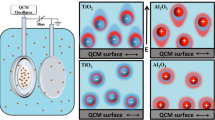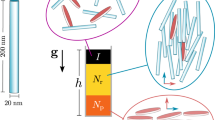Abstract
Electrorheology (ER) denotes the control of a material's flow properties (rheology) through an electric field1,2,3,4,5,6,7,8,9,10. We have fabricated electrorheological suspensions of coated nanoparticles that show electrically controllable liquid–solid transitions. The solid state can reach a yield strength of 130 kPa, breaking the theoretical upper bound on conventional ER static yield stress that is derived on the general assumption that the dielectric and conductive responses of the component materials are linear. In this giant electrorheological (GER) effect, the static yield stress displays near-linear dependence on the electric field, in contrast to the quadratic variation usually observed11,12,13,14,15,16. Our GER suspensions show low current density over a wide temperature range of 10–120 °C, with a reversible response time of <10 ms. Finite-element simulations, based on the model of saturation surface polarization in the contact regions of neighbouring particles, yield predictions in excellent agreement with experiment.
This is a preview of subscription content, access via your institution
Access options
Subscribe to this journal
Receive 12 print issues and online access
$259.00 per year
only $21.58 per issue
Buy this article
- Purchase on Springer Link
- Instant access to full article PDF
Prices may be subject to local taxes which are calculated during checkout



Similar content being viewed by others
References
Whittle, M. & Bullough, W.A. The structure of smart fluids. Nature 358, 373–373 (1992).
Halsey, T.C. Electrorheological fluids. Science 258, 761–766 (1992).
Clercx, H. & Bossis, G. Many-body electrostatic interaction in electrorheological fluids. Phys. Rev. E 48, 2721–2738 (1993).
Tao, R. & Sun, J.M. Three-dimensional structure of induced electrorheological solid. Phys. Rev. Lett. 67, 398–401 (1991).
Gamota, D.R. & Filisko, F.E. Linear and nonlinear mechanical-properties of electrorheological materials. Int. J. Mod. Phys B 6, 2595–2607 (1992).
Chen, Y., Sprecher, A.F. & Conrad, H. Electrostatic particle–particle interaction in electrorheological fluids. J. Appl. Phys. 70, 6796–6803 (1991).
Davis, L.C. Ground-state of an electrorheological fluid. Phys. Rev. A 46, R719–R721 (1992).
Martin, J.E., Odinek, J., Halsey, T.C. & Kamien, R. Structure and dynamics of electrorheological fluids. Phys. Rev. E 57, 756–775 (1998).
Anderson, R.A. in Electrorheological Fluids (ed. Tao, R.) 81–90 (World Scientific, Singapore, 1992).
Davis, L.C. Polarization forces and conductivity effects in electrorheological fluids. J. Appl. Phys. 74, 1334–1340 (1992).
Garino, T., Adolf, D. & Hance, B. in Electrorheological Fluids (ed. Tao, R.) 167–174 (World Scientific, Singapore, 1992).
Randall, C.A., McCauley, D.E., Bowen, C.P., Shrout, T.R. & Messing, G.L. in Electrorheological Fluids (eds Tao, R. & Roy, G.D.) 60–66 (World Scientific, Singapore, 1994).
Liang, R. & Xu, Y. in Electrorheological Fluids (eds Tao, R. & Roy, G.D.) 233–250 (World Scientific, Singapore, 1994).
Randall, C.A., Bowen, C.P., Shrout, T.R., Messing, G.L. & Newnham, R.E. in Electrorheological Fluids (eds Tao, R. & Roy, G.D.) 516–525 (World Scientific, Singapore, 1994).
Ma, H.R., Wen, W., Tam, W.Y. & Sheng, P. Frequency dependent electrorheological properties: origin and bounds. Phys. Rev. Lett. 77, 2499–2502 (1996).
Tam, W.Y. et al. New electrorheological fluid: theory and experiment. Phys. Rev. Lett. 78, 2987–2990 (1997).
Handbook of Chemistry and Physics 62nd edn (eds Weast, R.C. & Astle, M.J.) (CRC, Boca Raton, 1981–1982).
Ma, H., Wen, W., Tam, W.Y. & Sheng, P. Dielectric electrorheological fluids: theory and experiment. Adv. Phys. 52, 343–383 (2003).
Atten, P., Foulc, J.-N. & Felici, N. A conduction model of the electrorheological effect. Int. J. Mod. Phys. B 8, 2731–2745 (1994).
Davis, L.C. & Ginder, J.M. in Progress in Electrorheology (eds Havelka, K.O. & Filisko, F.E.) 107–114 (Plenum, New York, 1995).
Landau, L.D. & Lifshitz, E.M. Theory of Elasticity 3rd edn (Pergamon, Oxford, 1986).
Neugebauer, C.A. & Webb, M.B. Electrical conduction mechanism in ultrathin, evaporated metal films. J. Appl. Phys. 33, 74–82 (1962).
Hill, R.M. Electrical conduction in ultra thin metal films. I. Theoretical. Proc. R. Soc. Lond. A 309, 377–395 (1969).
Proc. 8th Int. Conf. Electrorheological Fluids and Magnetorheological Suspensions (ed. Bossis, G.) (World Scientific, Singapore, 2002).
Clark, I.J., Takeuchi, T., Ohtori, N. & Sinclair, D.C. Hydrothermal synthesis and characterization of BaTiO3 fine powders: precursors, polymorphism and properties. J. Mater. Chem. 9, 83–91 (1999).
Xu, H. & Gao, L. New evidence of a dissolution-precipitation mechanism in hydrothermal synthesis of barium titanate powders. Mater. Lett. 57, 490–494 (2002).
Wen, W., Zheng, D. & Tu, K. Experimental investigation for the time-dependent effect in electrorheological fluids under time-regulated high pulse electric field. Rev. Sci. Instrum. 69, 3573–3576 (1998).
Jackson, J.D. Classical Electrodynamics 2nd edn (Wiley, New York, 1975).
Acknowledgements
This research was partially supported by CERG HKUST6065/02P and NSFC No.10029401. We thank Y. Zheng for help in TEM pictures. W.W. and P.S. also thank C. T. Chan and W. K. Ge for support.
Author information
Authors and Affiliations
Corresponding author
Ethics declarations
Competing interests
The authors declare no competing financial interests.
Rights and permissions
About this article
Cite this article
Wen, W., Huang, X., Yang, S. et al. The giant electrorheological effect in suspensions of nanoparticles. Nature Mater 2, 727–730 (2003). https://doi.org/10.1038/nmat993
Received:
Accepted:
Published:
Issue Date:
DOI: https://doi.org/10.1038/nmat993
This article is cited by
-
Development of cornstarch-based shear thickening fluid and characterization of the effects of the addition of halloysite nanotubes-silica hybrid reinforcements
Journal of Polymer Research (2023)
-
Small-angle X-ray scattering study on the orientation of suspended sodium titanate nanofiber induced by applied electric field
Radiation Detection Technology and Methods (2019)
-
Comparative study of the electrorheological effect in suspensions of needle-like and isotropic cerium dioxide nanoparticles
Rheologica Acta (2018)
-
Analysis of the static yield stress for giant electrorheological fluids
Korea-Australia Rheology Journal (2017)
-
Effect of carrier liquid on electrorheological performance and stability of oxalate group-modified TiO2 suspensions
Journal of Wuhan University of Technology-Mater. Sci. Ed. (2017)



